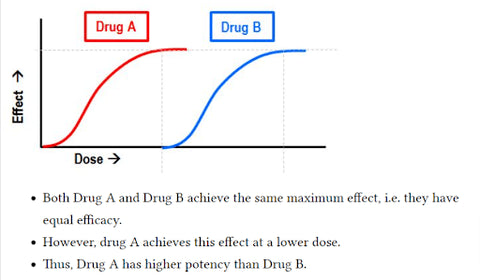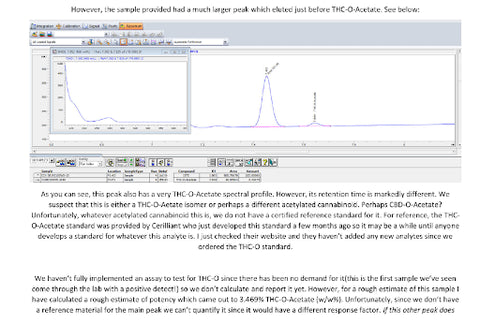THC-O: The New Illegal Substance
Cannabis lovers have watched highly anticipated, high-inducing cannabinoids divide the hemp industry for the last few months. With an ever-growing marketplace, hemp companies are looking for an edge, and some are turning to controversial, synthetic cannabinoids such as HHC and THC-O. Marketing the artificial compounds as "new,” "rare," or "extremely potent" without disclosing the facts - these compounds are neither legal nor safe. However, the bold claims presented by some companies are driving tremendous interest.
The cause for attraction is due to the higher potency of their therapeutic and psychoactive properties. The consequence of this is that sales of extracts are snowballing, which is why the unnatural, synthetic cannabinoid known as THC-O acetate is one of the substances gaining attention. The continuation of prohibition has been a catalyst to this kind of development of products that people would like to think are legal but are not. Not only are people being drawn to the higher potency, but there is a misbelief that higher potency substances bear higher benefits.
However, in this study, you can see that higher potency does NOT equal higher efficacy or improved benefits.
“Both A and B achieve the same maximum effect, i.e., they have equal efficacy.”

THC-O acetate, or THC-O, is a synthetic analog of THC. That means that THC-O is not naturally occurring and can only be manufactured via modern cannabis tech. The main reason it’s gaining rapid popularity and becoming the topic of conversation is that it is said to produce effects three times stronger than conventional THC. This might seem exciting to the regular cannabis user, but on the contrary, it’s anything but exciting. THC-O’s potency and chemical composition suggest an uncertain future.
So, what is THC-O acetate, and how is it derived?
According to the United States Patent for THC-O;

“Tetrahydrocannabinol (THC) in cannabis oil reacts with acetic anhydride under reflux to produce THC-O-acetate and acetic acid.”
The process requires material high in THC (typically includes 75-90% THC and 5% other cannabinoids). Specifically, the material that is needed to produce THC-O is THC Delta-9 Distillate. The method of making THC-O acetate is inherently dangerous. The acetic anhydride that's part of the process is highly flammable and potentially explosive. This has to be done in a technical lab, which adds additional layers of complication to an already toxic outcome.
The patent explicitly states the definition of THC as;
“A phytocannabinoid molecule that is found in the cannabis plant mostly in its acidic form, tetrahydrocannabinolic acid (THCA)...THC is known for its psychoactive effect when consumed or inhaled. It is more correctly known as delta-9-tetrahydrocannabinol.”
It then clarifies that THC levels in cannabis plants are typically very low, e.g., <2%. THC is known for its psychoactive effect when consumed or inhaled, and It is more correctly known as delta-9-tetrahydrocannabinol, not to be confused with other forms of THC such as Delta-8.
The patented process requires a reflux reaction between decarboxylated cannabis oil, which has a presence of THC, and acetic anhydride occurs, resulting in a crude product of THC-O-acetate. It then states that you can, in fact, utilize the process using other cannabinoids; however, the result is an entirely different variant and is not THC-O as some companies may be claiming it to be.
“As an alternative, the whole process may be applied for the acetylation of cannabinoids other than THC such as CBD, CBG, and CBN.”
What are its effects?
In the book ‘Marijuana Potency’ by Michael Starks, he classifies THC-O-acetate as 300% stronger than the THC we all know, which explains why many liken its effects to that of the psychedelic realm. Although few people have tried it, and little research has been done, it is spiritual and introspective. in the 1974 book Cannabis Alchemy: Art of Modern Hashmaking by Author D. Gold; he stated the following;
"The effect of the acetate is more spiritual and psychedelic than that of the ordinary product.”
While the exact effects aren’t widely known, we do know that it takes far longer for the user to feel its effects. The effects only activate and become noticeable once enzymes deacetylate the THC-O-acetate in the body, which is highly unusual compared to regular THC. After administration, the substance is metabolized, and only then are the effects felt - which makes it prodrug.
What is the history behind THC-O-acetate?
THC-O-acetate was first investigated between 1949 and 1975. It was being tested as a non-lethal incapacitating agent on dogs but was soon after found to be almost twice as strong as regular THC.
THC-O-acetate’s first encounter with the U.S. DEA was in 1978; the DEA expressed concerns that THC-O-acetate was being made analogously, similar to how heroin is made from morphine, but that was classified as an isolated incident, so the suggestion of making it a controlled substance was dropped. Similarly, in 1995, the United Kingdom ruled THC-O-acetate as a class A drug. It has only been until recently, around 2018 when the USA’s legal changes erased restrictions on the cultivation of industrial hemp.
So what exactly is the issue with THC-O-acetate?
Most labs cannot provide a potency analysis for THC-O. This poses a massive issue for the industry as a number of companies are selling ‘THC-O’ that is clearly not THC-O, and have no reference of standard from a credible 3rd party. ChemHistory, a credible lab used by many, explained that while they have the THC-O standard, they couldn’t quantify the exact target analyte of the analyzed sample because no CRM for this material currently exists.
“We do not have a certified reference for it. For reference, the THC-O-Acetate standard was provided by Cerilliant, who just developed this standard a few months ago.
ChemHistory is familiar with the standard for testing THC-O but cannot identify the exact analyte submitted (on-hand) because it’s not THC-O. On pg. 13 of the report, the tech analysis explains that the submitted isomer is similar in appearance but not THC-O and was likely created using something other than Delta-9 Distillate (required for producing THC-O). They state that if THC-O-acetate were the goal of this production, using THC Delta-9 distillate would have yielded higher and more accurate results.
“As you can see, this peak also has a very THC-O-Acetate spectral profile. However, its retention time is remarkably different. We suspect that this is either a THC-O-Acetate isomer or perhaps a different acetylated cannabinoid. Perhaps CBD-O-Acetate?”

As previously mentioned, the material that is needed to produce THC-O is THC Delta-9 Distillate. You can make similar isomers using other sources such as THC Delta-8 as opposed to D-9, but as mentioned in the tech notes (lab analysis above), the result is not the same. If THC Delta-8 is used as the source material, the result is CBD-O-Acetate, NOT THC-O-Acetate.
The main problem is that hemp companies do not have the licensing to possess Delta-9 distillate as this is a marijuana extract. Furthermore, if they attempt to create THC-O with a different base, such as THC-Delta 8, the result is CBD-O and not THC-O. Thus some may be using a "hemp-derived product," but in using the incorrect source material, They're mislabeling the product as THC-O when in-fact, it’s not.
What are some concerns about how THC-O-acetate may be used?
The fear of the fraud and illegality behind the substance is a top concern.
- As stated above in the tech notes, no standard currently exists for the material these companies are submitting - which means that hemp Companies cannot reliably report the potency of the CBD-O that they’re claiming to be THC-O.
- Hemp companies are marketing a THC-O isomer, or perhaps a completely different acetylate cannabinoid (as mentioned in the lab report) as THC-O, which is a blatantly false claim, and borderline fraud.
Our concern lies in the fact that companies are taking advantage of an uneducated marketplace for monetary gain. Pursuing higher potency has been an ongoing goal of the industry for years, but illegally creating a product and falsely marketing it as such is not accelerating the industry’s growth.
How are companies contributing to the problem?
For one, companies are exploiting "new" and "rare" cannabinoids at an alarming rate, using processes that are not standardized, dangerous, and toxic. A lack of research and regulation based on actual data means that mysteries about THC-O acetate are prevalent. A company should not be selling anything that is not backed by enough research or data. This means that companies are creating products with wide variations of quality due to the lack of data. As we saw from the lab report above, companies are likely getting far less pure of a product than what they’re marketing.
Companies exploit the miseducation in the industry and purposefully find loopholes in the legislation to pursue a dangerous, toxic, and illegal product. Companies should be well aware of the Federal Analogue Act, which states;
“any chemical "substantially similar" to a controlled substance listed in Schedule I or II to be treated as if it were listed in Schedule I.”
Products with THC-O exist in the marginal legal space between hemp, which is legal, and cannabis - which is not federally legal and is highly regulated in the states that allow it. THC-O needs to come under a state-regulated system before consumer consumption to ensure they can weigh the benefits themselves. With companies falsely advertising the end product - the consumer can’t understand and consider the risks and benefits. Companies should follow safe practices and perform their due diligence before offering the latest, but certainly not the greatest, cannabinoids.
The industry is complicated, but unlicensed hemp-derived products are undercutting the market and tarnishing the reputation of an industry that has spent decades building a focus around health and wellness. As a consumer, you should have complete confidence that what you’re buying is what you’re getting - and you should have comfort in the fact that your chosen company puts your health first. It’s up to you to educate yourself and stand against companies advocating for substances like this.
The daunting reality is; when companies are calling a substance something that it isn't, can you imagine what else they're not telling you?
Sources for further reading:









